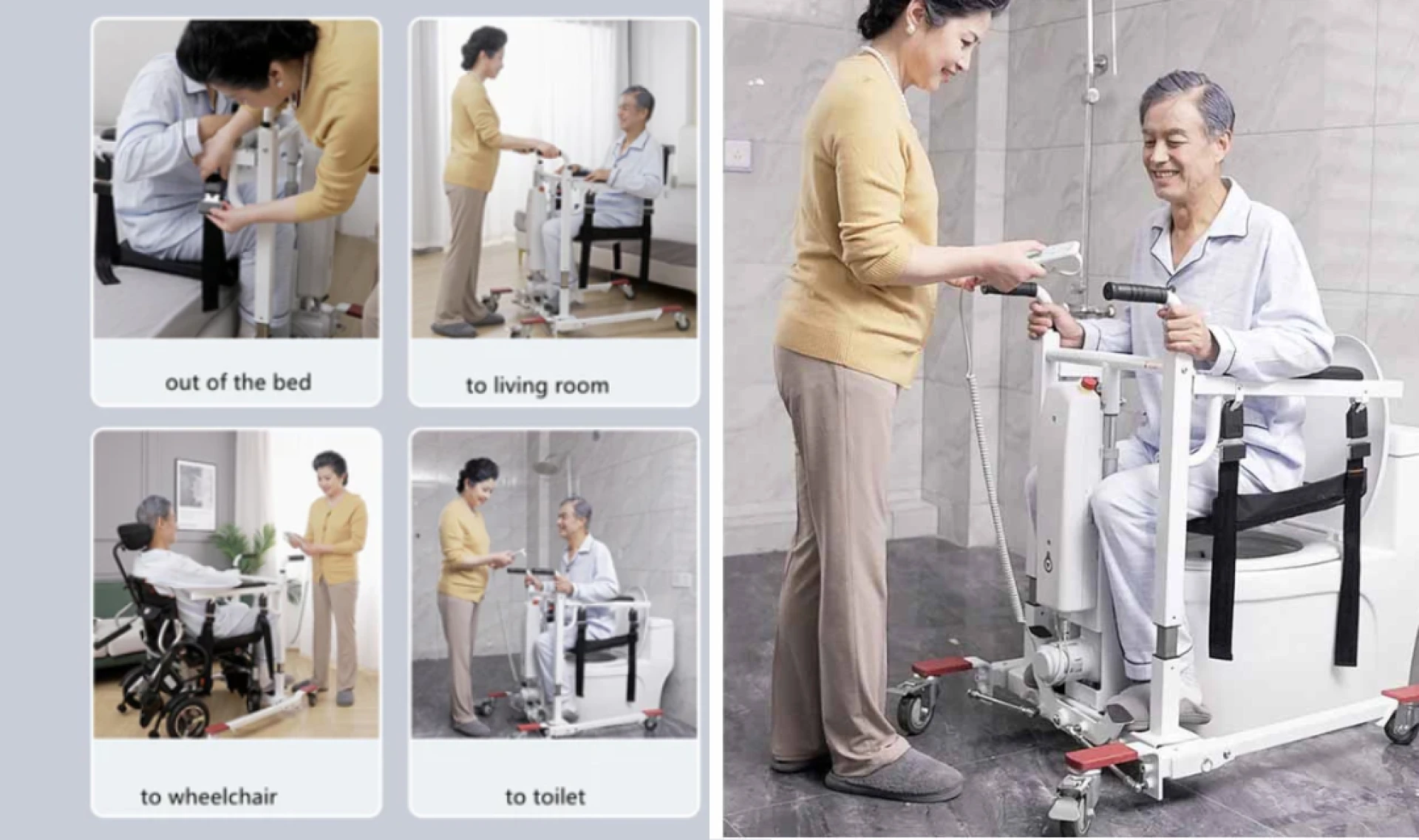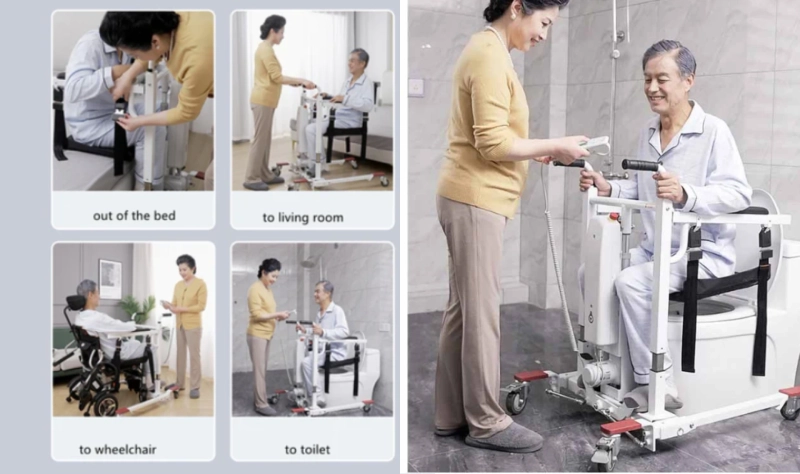Compassion, Safety, and a Smarter Way to Transfer Patients Without Risk or Injury
Every day, thousands of caregivers—whether family members or professionals—face one overwhelming challenge: how to safely transfer a patient or elderly loved one at home.
Whether it’s getting someone out of bed, onto a toilet, into a car, or simply moving them to a chair at the dinner table, patient transfers are one of the most physically demanding, emotionally stressful, and injury-prone responsibilities in caregiving.
Unfortunately, far too many households still rely on unsafe manual lifting or makeshift methods—like pulling underarms, bending awkwardly, or struggling to pivot the patient—often resulting in back injuries, falls, or trauma.
The Hidden Struggles of Patient Transfers at Home
Transferring patients with limited mobility isn’t just hard—it can be dangerous.
- Caregivers risk back injuries, pulled muscles, and chronic pain
- Patients feel vulnerable, anxious, and even humiliated during unsafe lifts
- Without proper equipment, every transfer becomes a moment of risk
The emotional toll is just as heavy. Many caregivers feel guilt and helplessness, especially when their loved one cries out in pain or fear during a move.
Why Manual Patient Transfers Are Risky
According to the CDC, caregiver back injuries are one of the leading causes of work-related disability in healthcare. And in homes, the risk is even higher because most caregivers aren't trained professionals.
Common problems with unsafe transfers include:
- Falls from misbalanced lifting or slippery surfaces
- Dislocated joints or pulled limbs from incorrect handling
- Strain injuries to caregivers' backs, shoulders, or knees
- Emotional trauma from stressful or painful moves
That’s why safe patient transfer techniques and tools are no longer optional—they’re essential.
What’s the Best Way to Transfer a Patient or Elderly Person at Home?
The safest way to transfer a patient at home is to use a mechanical or electric patient lift transfer chair that allows the individual to remain seated and secure throughout the process.
Instead of bending, lifting, and pivoting, you use an electric remote to raise and lower the patient smoothly—transferring them from the bed to a toilet, to a wheelchair, or even directly into a car seat or shower chair.
Introducing the Game-Changer: The MedMobility Electric Patient Lift Transfer Chair
Meet the most compassionate innovation in modern caregiving: the MedMobility Electric Patient Lift Transfer Chair.
Unlike traditional  that rely on slings, pulleys, and overhead lifting, this is a chair-based lift that allows direct, seated transfers—making the entire experience smoother, safer, and far more dignified for both the patient and caregiver.
that rely on slings, pulleys, and overhead lifting, this is a chair-based lift that allows direct, seated transfers—making the entire experience smoother, safer, and far more dignified for both the patient and caregiver.
Why This Patient Lift Transfer Chair Changes Everything
🔹 It’s a Chair, Not a Sling
No more dangling in a sling. Patients stay comfortably seated as they are gently lifted and transferred to their next location.
🔹 Electric Power, Zero Strain
A whisper-quiet 24V motor does all the work. With just a touch of the remote, the chair raises and lowers the patient effortlessly.
🔹 Transfers to Bed, Toilet, Car, Dining Table & More
This versatile electric patient transfer chair aligns easily with beds, bathrooms, wheelchairs, and even car doors—thanks to its adjustable leg width and customizable height.
🔹 Includes Solid & Commode Seats
Every chair comes with both a solid seat and a commode seat + bucket for bathroom use—ready for whatever the day brings.
🔹 Compact, Foldable, and Portable
Despite its power, this chair folds quickly and fits in most car trunks—making it ideal for appointments, travel, or simply tucking away when not in use.
🔹 Designed with Safety in Mind
Locking rear casters prevent movement during transfers, and a strong powder-coated frame supports up to 330 lbs with absolute stability.
Who Can Benefit from This Electric Patient Transfer Chair?
- ✅ Family caregivers caring for elderly parents or disabled loved ones
- ✅ Seniors with limited mobility who want to maintain dignity
- ✅ Home care providers looking to minimize risk
- ✅ Rehabilitation centers, nursing homes & long-term care facilities
- ✅ Patients transitioning from hospital to home after surgery or injury
Frequently Asked Questions About Safe Patient Transfers
How do you safely transfer an elderly person from bed to wheelchair?
Use a patient lift transfer chair that allows the person to remain seated. Align the chair, use the remote to raise them to the desired height, and roll them directly to the wheelchair or toilet without lifting.
What is the safest method for patient transfers at home?
The safest method is using an electric patient transfer chair that avoids manual lifting, reduces risk, and ensures comfort for the patient.
Is this better than a Hoyer lift?
Yes. Traditional Hoyer lifts require slings and multiple adjustments. The MedMobility chair allows seated transfers directly to the toilet, bed, or car—making it easier, faster, and safer.
Can this be used for bathroom and commode transfers?
Absolutely. It comes with a commode seat and bucket, making it a great option for bathroom routines or bedside use.
Does it fit in a car for travel?
Yes! The chair folds compactly and fits in most car trunks, making it ideal for doctor visits or travel.
Final Thoughts: Safe Transfers = Safer Care
Caregiving should never come at the cost of your health—or your loved one’s dignity. With the MedMobility Electric Patient Lift Transfer Chair, you gain peace of mind, ease of use, and a safe, reliable way to help someone you care about.
It’s not just equipment—it’s empowerment.
Click here to learn more or order yours today.
Don't wait until another risky transfer causes injury. Take the step toward safe, comfortable, and dignified caregiving now.


